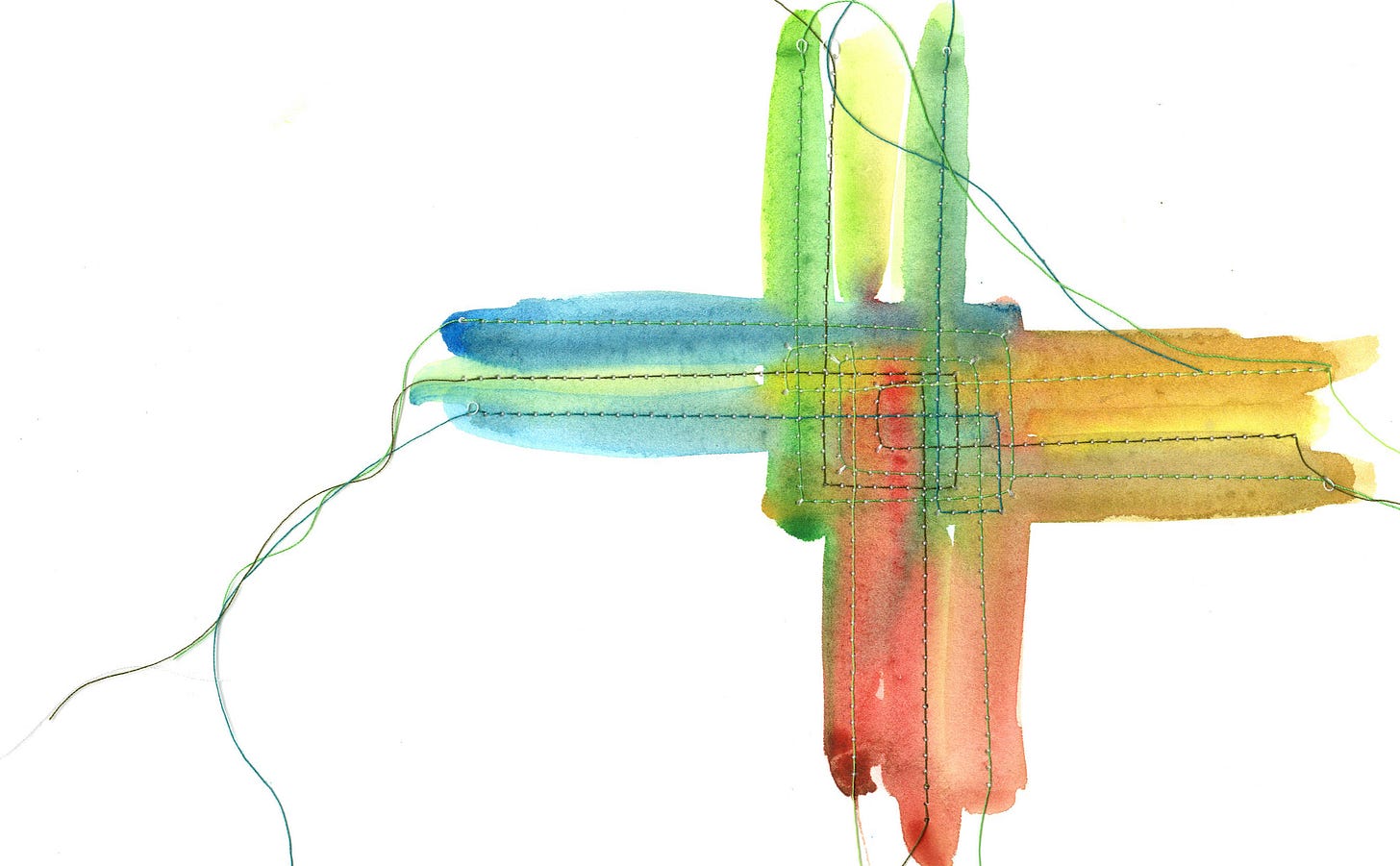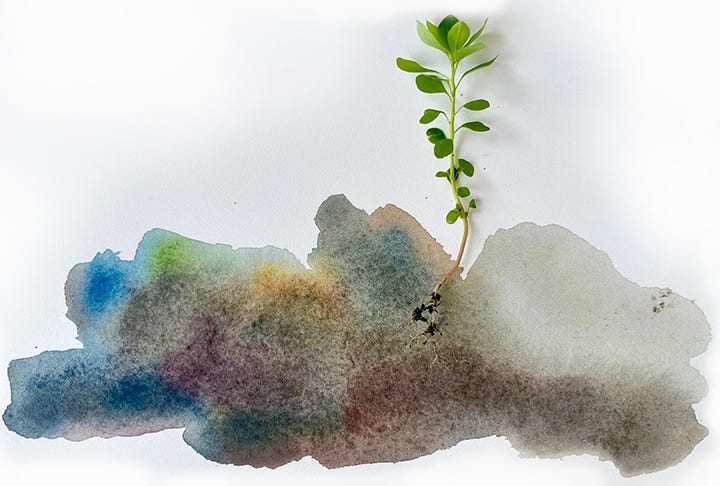Groundhogs and Regenerative Change
Moving consciously through seasons of change and confronting shadows as a reflection
Welcome new subscribers and welcome back long-time subscribers. It's been a bit since I last posted. I've been 'wintering' for some time, pausing on sharing my voice here. With the seasons changing, I hope to be back with more. And on that note, I hope you enjoy this piece.
"I don't get it," my daughter says. "If the groundhog sees its shadow, it's six more weeks of winter, but if it doesn't see its shadow, it's six more weeks until spring. Isn't that just the same thing?" Sort of… the six weeks could be unusually cold (i.e., six more weeks of winter) or unusually sunny (six more weeks until spring). "But in order for the groundhog to see its shadow, it needs to be sunny out, so wouldn't the sun being out to be more spring?" These are all fair questions for my 11-year-old to ponder.
Last Friday was Groundhog Day. The midpoint between the winter solstice and the spring equinox has been celebrated in many different cultures before Phil the immortal groundhog became a weather forecaster from Puxatawny, PA. Imbolc, the ancient Celtic holiday, is celebrated on February 1st and marks the start of spring in the Galic seasons. Meaning 'in the belly,' Imbolc is sometimes seen as a time to cleanse and prepare for birth. As a Pagan festival, it is associated with the lambing season - when the ewe's milk comes in. St. Brigid's also shares this day and is celebrated with Brigid's crosses, which folklore tells us could be symbols of deathbed conversions or ways to neutralize toxins. Christians took the holiday to celebrate Candlemas - 40 days after (Christ's birth on) December 25th being February 2nd. In farming traditions, it's a time when farmers analyzed the weather to estimate the labor and supplies needed for that year's crops. As bears, foxes, hedgehogs, and badgers emerged from hibernation, the weather-predicting lore evolved again as a prediction via shadow. Whether it's a groundhog, farm planning, a patron saint warding off evil spirits, or a time to milk sheep, it's a day that reflects a midpoint of reflection to prepare for what's next.
Seasons of Change
Part of regenerative design is learning from and aligning with nature - just one of the many principles from Indigenous cultures. One way we connect with nature is through seasons.
As part of my sabbatical from my work as a Professor, I've been spending time as a student, including participating in the Regenerative Change Lab's Navigation course. Somewhat serendipitously, last week, our discussion focused on seasons and the need to work through all of them as part of the process.
Wintering is often a time for slowing down and healing, renewing our purpose, and cultivating conditions for new emergence. This leads to Springing, which brings birth, ideation, and creation cycles, enabling growth. Summering gives us cycles of growth and abundance, aligning with purpose. This, in turn, leads to Autumning decay, composting, and preparing to let go in the following winter… and so the cycle continues. In our consumerist, capitalist societies, we often want to live in an endless summer of growth and abundance. But we need the other seasons to keep our practice in balance. These seasons can be both literal and metaphorical. In order to grow, we must also let go, rest, and restore. In recent times, there has been a rise in conversations around climate grief - acknowledging what we need to let go of. Letting go is an essential step in making space for something new to emerge. All of the seasons are necessary; they can't be skipped, and they need to work together.
However, unlike our consumerist society that switches overnight to Valentine's Day sales on December 26th (if not before), the way we move between seasons has more of an ebb and flow, a back and forth, than a hard date to make a sharp turn. Reflection is needed to move between the seasons.
The groundhog then allows us to consider how we will spend the next six weeks leading up to the spring equinox. Do we need more time to winter? Or more time to spring? Just as groundhogs across the country predicted mixed results based on local weather, we as individuals may also have different answers.
Working in regenerative change can be challenging to work in new systems while living in our current ones. I was reminded of this firsthand last month. Like most people, my November-December was overloaded with holidays, celebrations, and gift-giving mixed in with all the everyday life things still needed to go on. I was so ready when January came to hit the ground running and start the new year refreshed. I would recommit to writing and running and doing all the things we're told/sold will make great January resolutions. Instead, on January 3rd, I was in bed with a cold. And I stayed there for a few weeks. Not COVID, not RSV, just a good old-fashioned cold that all the tea and rest wouldn't shake, and instead, it was left just to run its course. When I map this onto the idea of wintering - this makes perfect sense. While I did celebrate lighting the darkness to ring in the Winter Solstice, wintering is not about starting new things - it's about slowing down, letting go, healing, and preparing for what's next. These seasons can't be rushed. If the soil is not prepared, you won't get a healthy crop. I spent my January wintering rather than renewing.
Shadows
The groundhog's prediction is based not on temperature, precipitation, or humidity but on whether it will see its shadow. Working with a Jungian therapist for some time, I've found metaphor and meaning in shadows. My daughter is correct that the groundhog needs sun to see its shadow, lightness, and dark; a yin and yang; both are needed.
Our shadow is the part of ourselves we usually set aside and try to hide, our hidden emotions, talents, desires, and fears that operate in our unconscious mind, influencing who we are. Our shadow is often the part of us we don't want others to see. To face our shadow is to embrace our whole self, allowing us to live a more authentic life. Jung is frequently quoted as saying, "One does not become enlightened by imagining figures of light, but by making the darkness conscious." In confronting its shadow, the groundhog turns inward for further reflection.
Beyond our own inner shadows, we also share in collective shadows. The continued growth of homelessness in the US as the wealth gap grows, the exploitation of child labor even in our own country so that we can continue to afford cheap food, and the disproportionate amount of pollution pumped into low-income communities so that higher income brackets can live more comfortably. In our collective shadows, the roots of the underlying systemic issues behind the climate crisis continue to grow. Continuing to ignore them is to continue our climate destruction. In simple terms, confronting these shadows is at the heart of the climate justice movement, giving power to those most harmed. Only when we make these issues conscious, giving light to them, facing the reality that they are connected to our existence, only then will we be able to cultivate the ground for regenerative life in the climate crisis.
Reflections
We each move in and out of seasons and in and out of our shadows at different times, in different ways. Whether your groundhog predicted six more weeks of spring or six more weeks of winter, what's more important is moving through that time consciously with the intention of generating new growth.
We have a new puppy in my family that my girls suggested to stand in for a groundhog. Last Friday, we took him out to test his prediction on an overcast rainy Oakland morning. I suspected there would be no shadow with the gloomy morning, but he surprised us by finding his shadow in our wet backyard. "Bruce thinks it will be winter," my 8-year-old giggled as he made his inaugural prediction. Later that day, at the dinner table, she questioned this - "if what he saw was in a puddle, wasn't that his reflection and not his shadow?" It’s another good question, I told her, for aren't all our actions simply reflections of ourselves? How then, might we reflect a better world rooted in climate justice that can regenerate growth?




